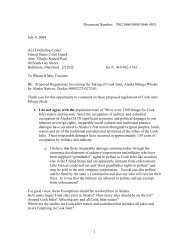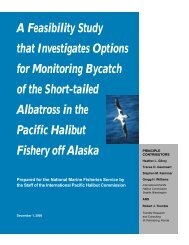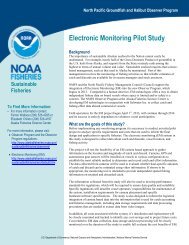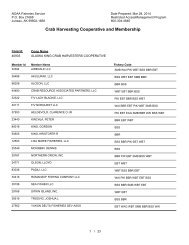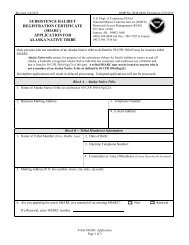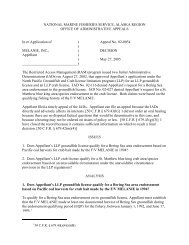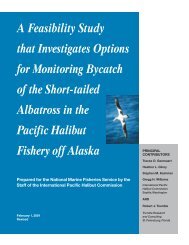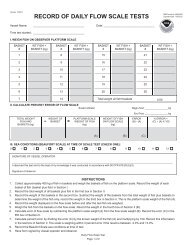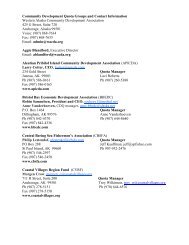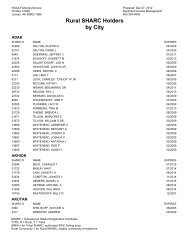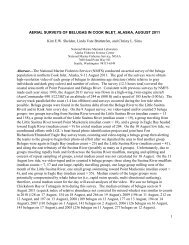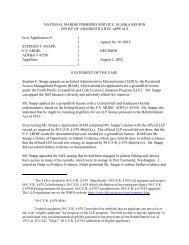Petition to List Lynn Canal Pacific Herring under the Endangered ...
Petition to List Lynn Canal Pacific Herring under the Endangered ...
Petition to List Lynn Canal Pacific Herring under the Endangered ...
You also want an ePaper? Increase the reach of your titles
YUMPU automatically turns print PDFs into web optimized ePapers that Google loves.
APPENDIX A: HERRING GENETICS<br />
This appendix contains information reported from genetic studies performed on<br />
<strong>Pacific</strong> <strong>Herring</strong> and Atlantic <strong>Herring</strong>. Only one study, Grant and Utter (1984), contains<br />
specific genetic data on <strong>Lynn</strong> <strong>Canal</strong> <strong>Herring</strong>. Based on Grant and Utter (1984) and<br />
subsequent studies in Alaska, British Columbia, Washing<strong>to</strong>n and <strong>the</strong> Atlantic Ocean, this<br />
petition concludes that <strong>Lynn</strong> <strong>Canal</strong> <strong>Herring</strong> are a genetically discrete and significant<br />
population of <strong>Pacific</strong> <strong>Herring</strong>.<br />
Grant and Utter (1984) and O’Connell et al. (1998) showed that <strong>Pacific</strong> <strong>Herring</strong><br />
populations from <strong>the</strong> Bering Sea are genetically distinct and <strong>the</strong> Gulf of Alaska.<br />
Microsatellite analysis also suggests that some genetic structuring may also exist within<br />
<strong>the</strong> Gulf of Alaska (O’Connell et al. 1998).<br />
Grant expanded upon Utter’s initial work, and surveyed 40 allozyme loci in<br />
<strong>Pacific</strong> herring (Grant 1979, 1981; Grant and Utter 1984). Grant and Utter (1984)<br />
found 26 polymorphic loci in 21 samples collected from five areas throughout <strong>the</strong><br />
range of <strong>Pacific</strong> herring -- Asia, <strong>the</strong> nor<strong>the</strong>astern Bering Sea, <strong>the</strong> sou<strong>the</strong>astern<br />
Bering Sea, <strong>the</strong> Gulf of Alaska, and <strong>the</strong> eastern North <strong>Pacific</strong> Ocean (including<br />
samples from <strong>the</strong> Strait of Georgia and Hale Passage in Puget Sound) (Fig. 15).<br />
Their analyses revealed two main genetic s<strong>to</strong>cks: Asian-Bering Sea herring and<br />
eastern North <strong>Pacific</strong> herring, separated by a Nei’s genetic distance (D) (Nei<br />
1972) of 0.039 (Fig. 16). The authors postulated that <strong>the</strong>se two distinct s<strong>to</strong>cks<br />
arose because of restricted gene flow between <strong>the</strong>m, due <strong>to</strong> repeated Pleis<strong>to</strong>cene<br />
glaciation on <strong>the</strong> sou<strong>the</strong>rn coast of Alaska. Genetic differentiation was also<br />
detected among all five areas. However, only <strong>the</strong> Bering Sea and <strong>the</strong> Gulf of<br />
Alaska showed any significant genetic differentiation within an area. The samples<br />
from <strong>the</strong> eastern North <strong>Pacific</strong> Ocean, which include <strong>the</strong> two Puget Sound<br />
samples, were not genetically distinct from each o<strong>the</strong>r, even though <strong>the</strong> collection<br />
sites ranged from California <strong>to</strong> sou<strong>the</strong>ast Alaska. The average D value between<br />
pairs of samples within <strong>the</strong> eastern North <strong>Pacific</strong> Ocean was not significantly<br />
different from zero. A gene diversity analysis revealed that only 0.5% of <strong>the</strong><br />
observed variation was due <strong>to</strong> differences among populations within an area. The<br />
authors also reported a north <strong>to</strong> south cline in allele frequencies of <strong>the</strong> locus<br />
GAPDH-1* for eastern North <strong>Pacific</strong> Ocean samples. The reason for this is<br />
uncertain, but because no o<strong>the</strong>r loci showed a similar cline, one possible<br />
explanation is that selection is occurring at this locus.<br />
(S<strong>to</strong>ut et al. 2001).<br />
Several genetic studies of Alaska <strong>Pacific</strong> herring have also been conducted.<br />
Burkey (1986) analyzed 16 samples collected from seven locations by<br />
commercial herring fisheries within Prince William Sound, Alaska. He analyzed<br />
14 polymorphic allozyme loci but did not find any significant differences among<br />
samples, among locations, or between years within a location. A gene diversity<br />
I



